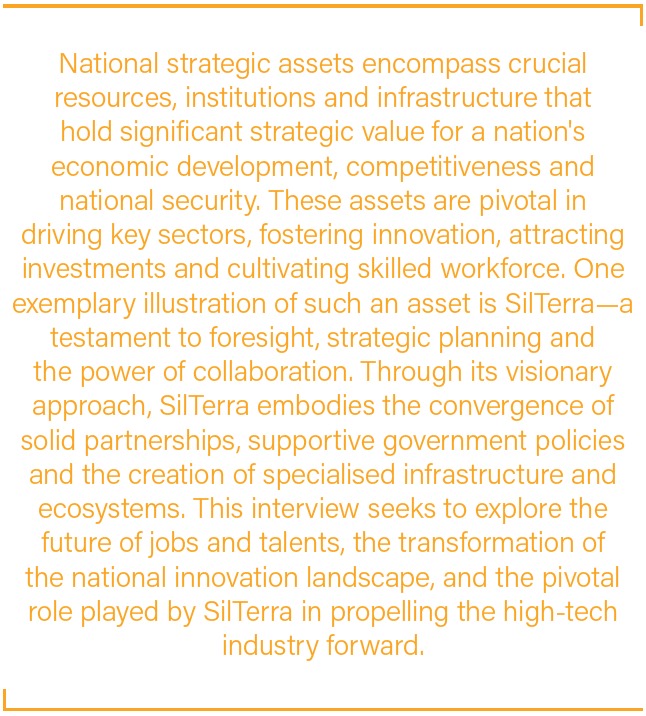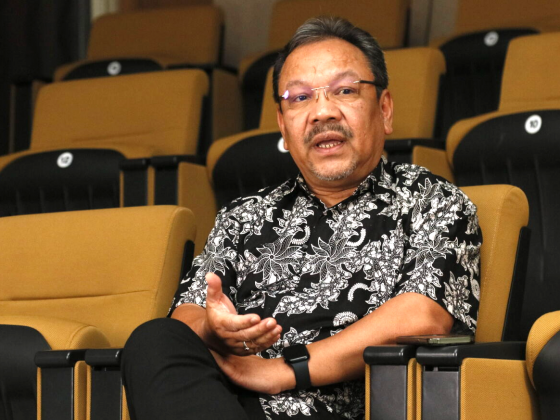Tan Sri Dato’ Sri Haji Syed Zainal Abidin Syed Mohamed Tahir, Chairman, SilTerra Malaysia
Yang Berbahagia Tan Sri Dato’ Sri Haji Syed Zainal Abidin Syed Mohamed Tahir is a prominent figure in Malaysia’s business and corporate world. With an illustrious career spanning several decades, he has made significant contributions to various industries and held numerous high-profile positions, including executive roles in leading multinational companies and government-linked corporations. Known for his exceptional leadership skills, strategic vision and unwavering commitment to excellence, Tan Sri Syed Zainal Abidin is widely respected as a trailblazer in the business community. Under his stewardship, numerous organisations have achieved unprecedented success, earned industry accolades, and solidified their positions as market leaders. It is an honour for myForesight® magazine to share his profound insights and visionary perspectives on the realms of technology, talent and tactical considerations.

Embracing Change: Adapting to the Tech-Driven Evolution of Business
Technological advancement and automation reshaping the future job landscape, holds immense importance when considering the impact of these changes. Over the past decade, we have witnessed an array of innovations, from the Internet of Things to digitalisation, reshaping industries. Undoubtedly, COVID-19 has accelerated this transformative wave and it is here to stay.
As entrepreneurs and companies, our role must evolve from resisting change to embracing it, adapting our operations to harness its advantages. Embracing change entails understanding how technological shifts will impact our businesses. Technology often enhances efficiency but raises questions about affordability and relevance to our specific industries. We must carefully select the technology that suits us and aligns with our affordability.
For instance, SilTerra has undertaken a substantial technology upgrade programme, focusing on both hardware and, more importantly, the skill sets of our people. Skill development is an ongoing process, and bridging gaps necessitates training, exposure, and collaboration with our customers to stay aligned with technological advancements.
Efficiency resulting from technological adaptation translates to improved revenue and cost reduction. It is the way forward, especially in the post-COVID era, where adaptability is vital. Those who quickly adapt thrive, while others face struggles.
In parallel, the evolving job landscape demands different skill sets. Our industry, the semiconductor sector, is a prime example. The shift from conventional Complementary Metal Oxide Semiconductor or CMOS to Silicon Photonics and more, requires specific knowledge not typically taught in universities. We must swiftly close this knowledge gap, which is why we have partnered with universities to align curriculum with industry needs.
Furthermore, the nature of work is changing. Traditional office spaces are becoming less necessary, with remote work proving effective. This shift necessitates flexible work environments and is a cultural shift within organisations to attract the best talent.
We have observed significant changes pre- and post-COVID, with technology adoption, cultural shifts and skillset demands evolving rapidly. Artificial intelligence, blockchain, data analytics and more are on the horizon, urging us to adapt continually.
However, it is essential to remember that we should be masters of technology, not the other way around. Technology should serve to facilitate business, not dictate it. Therefore, selecting the right technology tailored to our needs becomes paramount.
Essentially, we are on a journey where adaptation and collaboration are our compass points. Adapting wisely to technology’s ever-changing landscape ensures efficiency and relevance. We are also shaping our businesses and the future of work itself.
Creating Complete Ecosystems for Competitiveness
The importance of Research and Development (R&D) cannot be understated when it comes to continually upgrading our innovation capabilities and maintaining a competitive edge in the international market. To do this successfully, we must first recognise our strengths and weaknesses. Staying ahead of the curve means identifying where we excel and then building on those strengths.
For instance, Malaysia has a strong foothold in the electrical and electronics industry (E&E), with decades of experience. However, merely relying on past successes will not keep us competitive. We must adapt swiftly to the changes happening globally. A notable example is China, which has excelled by ensuring a complete supply chain for its industries. However, merely having strengths is not enough; we must build on them and ensure we do not fall behind.
One essential step is crafting a clear blueprint for the future. We must decide which sectors we want to grow and specialise in over the next five years. This blueprint should be comprehensive, involving key stakeholders, such as industry experts and government bodies, to ensure it aligns with our national interests.
Attracting investors is another critical aspect. We must be specific about the type of investments we want in our country, be it semiconductor manufacturing, IC design, or other areas within E&E. Providing the right incentives is essential to attract investors, making our country more competitive globally.
However, our human capital is equally important. As investors come in, we need to ensure we have a skilled workforce to meet their needs. This requires close coordination among the private sector, the Ministry of Human Resources, and the Ministry of Higher Education to bridge skill gaps effectively.
Building a complete ecosystem is imperative. This means controlling the entire supply chain, from raw materials to finished products. Having a robust local supply chain makes us more resilient to external disruptions.
To make these steps effective, we need an apparent, coordinated effort. One central body should oversee the entire strategy, avoiding fragmentation and ensuring all resources are harnessed optimally. This demands a unified approach from the government and industry players.
Innovation should be deeply ingrained in our culture, much like the Japanese “kaizen” principle. A culture of innovation requires recognition and reward systems that motivate individuals to think creatively and improve continuously. Sadly, we often lack a holistic innovation culture and system at the national level, hampering our progress.
Malaysia’s High-Tech Aspirations: Envisioning the Desired Future
Looking ahead to the next five to ten years, it is crucial that we adopt a forward-thinking approach while staying grounded in practicality. A prime example is the aspiration to become a hub for electric vehicle manufacturing. While this goal is ambitious, it is important to consider our size. Malaysia’s population, around 35 to 38 million, pales in comparison to countries like China, with over 1.4 billion, or Thailand, with 80 million.
In the automotive industry, scale matters, especially for electric vehicles, which rely on components like batteries. Batteries require substantial production volumes and transporting them by air is impractical due to their nature. Given these constraints, investing in becoming a primary electric vehicle manufacturing hub may not be Malaysia’s most pragmatic choice.
Instead, we could position ourselves as a hub for electric vehicle component manufacturing, focusing on electronics where our strengths lie. By identifying our strengths and understanding where we can excel, we can create a clear direction for growth. This approach applies to the automotive industry and the E&E sector.
For instance, in E&E, our strength lies in semiconductors. We can strive to be a global hub for high-end foundry manufacturing, attracting businesses worldwide with incentives and offering the necessary infrastructure. This approach not only brings in high-end technology manufacturers but also supports the growth of supporting industries and creates valuable job opportunities.
Looking beyond the present, we must consider emerging trends. Electric vehicles represent one such trend, but rather than focusing on battery production, we should concentrate on the electronics that power these vehicles. The automotive industry is evolving towards advanced electronics, including the potential for autonomous vehicles. These areas align with our skill sets and existing capabilities.
Furthermore, we should explore fields like life sciences and healthcare. Modern healthcare is increasingly reliant on advanced electronics and sensors for diagnostics. By investing in these technologies, such as silicon-based diagnostics, we can play a significant role in shaping the future of healthcare.
In the next five to ten years, areas like the Internet of Things (IoT) and 5G technology will continue to be in high demand. To meet these demands, we must focus on advancing our semiconductor capabilities to accommodate the growing need for memory and speed.
Collaboration is essential in this journey. Rather than trying to do everything alone, we should actively seek partnerships with global players. These partnerships can bring the necessary expertise and resources to accelerate our progress.
While the path to a high-tech future is promising, it requires a clear roadmap and targeted efforts. We cannot be everything to everyone. Additionally, engaging smartly with countries like China is crucial, recognising their role as a global economic powerhouse. To attract investments and foster growth, we must proactively approach potential investors rather than wait for them to come to us. Countries like Indonesia are setting examples in this regard.
In essence, Malaysia has the potential and the talent to thrive in the high-tech landscape of the future. However, our government must revisit the roadmap for the Electrical and Electronics (E&E) sector, bringing clarity and focus to our strengths.
We need a collaborative effort, strategic partnerships and proactive engagement with global players to succeed. With the right direction, Malaysia can secure its place as a global leader in cutting-edge technology.
“Furthermore, we should explore fields like life sciences and healthcare. Modern healthcare is increasingly reliant on advanced electronics and sensors for diagnostics. By investing these in these technologies, such as silicon-based diagnostics, we can play a significant role in shaping the future of healthcare.“








